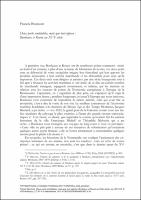Chapter Deux ports semblables, mais que tout oppose: Bordeaux et Rouen au XVIe siècle
| dc.contributor.author | Brumont, Francis | |
| dc.date.accessioned | 2022-06-01T12:10:37Z | |
| dc.date.available | 2022-06-01T12:10:37Z | |
| dc.date.issued | 2019 | |
| dc.identifier | ONIX_20220601_9788864538570_186 | |
| dc.identifier.issn | 2704-5668 | |
| dc.identifier.uri | https://library.oapen.org/handle/20.500.12657/56003 | |
| dc.description.abstract | The two major ports on the French Atlantic coast have many points in common, including the facilities of relations with their hinterland. But, in the sixteenth century, they had a very different destiny. Bordeaux was a passive port, waiting for the ships to load the products offered by its merchants (wine, pastel) and redistributing it in its hinterland. Rouen had to supply Paris and the Paris region, to bring raw materials for the Normandy industry and to look for outlets for its productions: this port therefore quickly turned to distant destinations where it could satisfy the needs of its economy. | |
| dc.language | French | |
| dc.relation.ispartofseries | Atti delle «Settimane di Studi» e altri Convegni | |
| dc.subject.other | economic history | |
| dc.subject.other | france | |
| dc.subject.other | commercial networks | |
| dc.subject.other | bordeaux | |
| dc.subject.other | rouen | |
| dc.subject.other | 16th century | |
| dc.title | Chapter Deux ports semblables, mais que tout oppose: Bordeaux et Rouen au XVIe siècle | |
| dc.type | chapter | |
| oapen.identifier.doi | 10.36253/978-88-6453-857-0.16 | |
| oapen.relation.isPublishedBy | bf65d21a-78e5-4ba2-983a-dbfa90962870 | |
| oapen.relation.isbn | 9788864538570 | |
| oapen.series.number | 50 | |
| oapen.pages | 19 | |
| oapen.place.publication | Florence |

